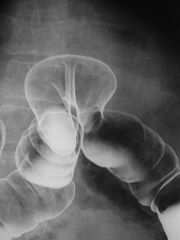Lower gastrointestinal series
Overview
A lower gastrointestinal series, also called a barium enema, is a medical procedure used to examine and diagnose problems with the human colon (large intestine). X-ray pictures are taken while barium sulfate fills the colon via the rectum.
Procedure

This test may be done in a hospital or clinic radiology department. The patient lies on the X-ray table and a preliminary X-ray is taken. The patient is then asked to lie on the side while a well lubricated enema tube is inserted into the rectum. As the enema enters the body, the patient might have the sensation that their stomach is being filled. The barium, a radiopaque (shows up on X-ray) contrast medium, is then allowed to flow into the colon. A small balloon at the tip of the enema tube may be inflated to help keep the barium inside. The flow of the barium is monitored by the health care provider on an X-ray fluoroscope screen (like a TV monitor). Air may be puffed into the colon to distend it and provide better images (often called a "double-contrast" exam). If air is used, the enema tube will be reinserted (if it had been removed; whether it is depends on who does the exam) and a small amount of air will be introduced into the colon, and more X-ray pictures are taken.
The patient is usually asked to move to different positions and the table is slightly tipped to get different views.
If there is a suspected bowel perforation, a water-soluble contrast is used instead of barium. The study is otherwise very similar, although the images are not quite as good. (The concern with existing perforation is that contrast will leak from the bowel to the peritoneal cavity, and water-soluble material is safer than barium, which must be removed.)
Preparation
Thorough cleaning of the large intestine is necessary for accurate pictures. Test preparations include a clear liquid diet, drinking a bottle of magnesium citrate (a laxative), and warm water enemas to clear out any stool particles.
Purpose
Barium enemas are most commonly used to check bowel health; they can help diagnose and evaluate the extent of inflammatory bowel diseases such as ulcerative colitis, Crohn's disease and irritable bowel syndrome (IBS). Polyps can be seen, though not removed during the exam like with a colonoscopy— they may be cancerous. Other problems such as diverticulitis (small pouches formed on the colon wall that can become inflamed) and intussusception can be found (and in certain cases the test itself can treat intussusception). An acute appendicitis or twisted loop of the bowel may also be seen.
In a healthy colon, barium should fill the colon uniformly and show normal bowel contour, patency (should be freely open), and position.
Additional conditions under which the test may be performed:
- Annular pancreas
- CMV gastroenteritis/colitis
- Hirschsprung's disease
- intestinal obstruction
- intussusception (children)
- pyloric stenosis
- endometriosis
Risks
There is low radiation exposure. X-rays are monitored and regulated to provide the minimum amount of radiation exposure needed to produce the image. Most experts feel that the risk is low compared with the benefits. Pregnant women and children are more sensitive to the risks of the X-ray.
A more serious risk is a bowel perforation, which is very rare.
Special considerations
CT scans and ultrasounds are now the tests of choice for the initial evaluation of abdominal masses, and colonoscopies are becoming the standard for routine colon screening for those over age 50 or with a familial history of polyps or colon cancer, although it is not uncommon for a barium enema to be done after a colonoscopy for further evaluation.
See also
External links
- RadiologyInfo - The radiology information resource for patients: Barium Enema
- NIH page on barium enemas
- CT colonography - An alternative to barium enemas
de:Colon-Kontrasteinlauf yi:באריום ענימע